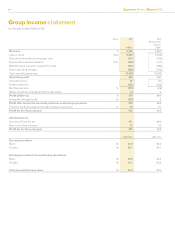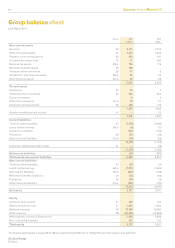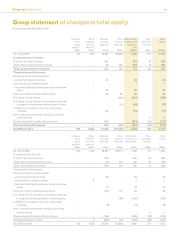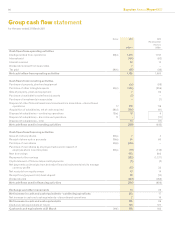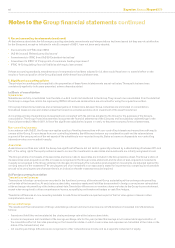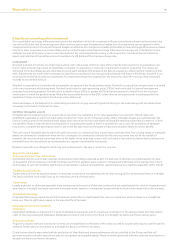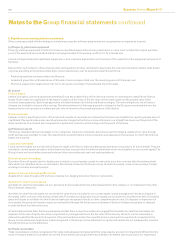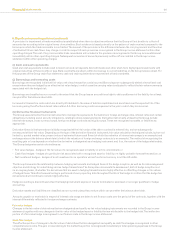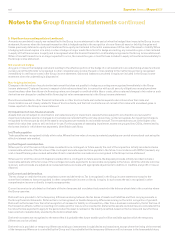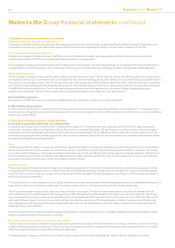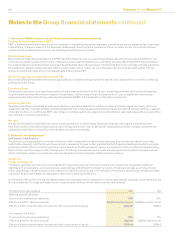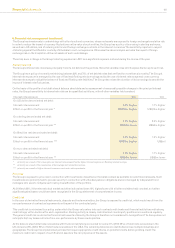Experian 2011 Annual Report Download - page 102
Download and view the complete annual report
Please find page 102 of the 2011 Experian annual report below. You can navigate through the pages in the report by either clicking on the pages listed below, or by using the keyword search tool below to find specific information within the annual report.
100 Experian Annual Report 2011
Notes to the Group nancial statements continued
5. Signicant accounting policies (continued)
Other costs associated with developing or maintaining computer software programmes are recognised as an expense as incurred.
(e) Property, plant and equipment
Property, plant and equipment is held at cost less accumulated depreciation and any impairment in value. Cost includes the original purchase
price of the asset and amounts attributable to bringing the asset to its working condition for its intended use.
Land is not depreciated and capitalised equipment on hire or lease is depreciated over the lower of the useful life of the equipment and period of
the lease.
Depreciation is provided on other property, plant and equipment at rates calculated to depreciate the cost, less estimated residual value based
on prices prevailing at the balance sheet date, of each asset evenly over its expected useful life as follows:
•Freehold properties are depreciated over 50 years;
•Leasehold properties with lease terms of 50 years or less are depreciated over the remaining period of the lease; and
•Plant and equipment is depreciated over two to ten years according to the estimated life of the asset.
(f) Leases
Finance leases
Leases of property, plant and equipment where the Group has substantially all the risks and rewards of ownership are classied as nance
leases. Such leases are capitalised at the lease’s inception at the lower of the fair value of the leased asset and the present value of the
minimum lease payments. Each lease payment is allocated between the liability and nance charges. The rental obligations, net of nance
charges, are included in loans and borrowings. The interest element of the lease payment is charged in the Group income statement over the
lease period so as to produce a constant periodic rate of interest on the remaining balance of the liability.
Operating leases
Leases in which a signicant portion of the risks and rewards of ownership are retained by the lessor are classied as operating leases and not
capitalised. Payments made under operating leases are charged in the Group income statement on a straight line basis over the period of the
lease. Incentives from lessors are recognised as a systematic reduction of the charge over the period of the lease.
(g) Financial assets
The Group classies its nancial assets in four categories: loans and receivables, derivatives used for hedging, assets at fair value through
prot and loss and available for sale. The classication is determined at initial recognition and depends on the purpose for which the nancial
assets are acquired.
Loans and receivables
Loans and receivables are non-derivative nancial assets with xed or determinable payments that are not quoted in an active market. They are
included in current assets, except for maturities more than one year after the balance sheet date which are classied as non-current assets. The
Group’s loans and receivables comprise trade and other receivables and cash and cash equivalents.
Derivatives used for hedging
Derivative nancial assets used for hedging are included in current assets, except for maturities more than one year after the balance sheet
date which are classied as non-current assets. Derivatives utilised by the Group include interest rate swaps, cross currency swaps, foreign
exchange contracts and equity swaps.
Assets at fair value through prot and loss
Assets at fair value through prot and loss comprise non-hedging derivative nancial instruments.
Available for sale nancial assets
Available for sale nancial assets are non-derivative nancial assets that are either designated to this category or not classied in the other
nancial asset categories.
Available for sale nancial assets are carried at fair value and are included in non-current assets unless management intends to dispose of
the assets within one year of the balance sheet date. Purchases and disposals of such assets are accounted for at settlement date. Unrealised
gains and losses on available for sale nancial assets are recognised directly in other comprehensive income. On disposal or impairment of
such assets, the gains and losses in equity are reclassied through the Group income statement. Gains and losses recognised on disposal
exclude dividend and interest income.
At each balance sheet date, the Group assesses whether there is objective evidence to suggest that available for sale nancial assets are
impaired. In the case of equity securities, a signicant or prolonged decline in the fair value of the security below its cost is considered in
determining whether the security is impaired. If any such evidence exists, the cumulative loss is removed from equity and recognised in the
Group income statement. Impairment losses recognised in the Group income statement on equity instruments are not subsequently reversed
through the Group income statement.
(h) Trade receivables
Trade receivables are initially recognised at fair value and subsequently measured at this value less any provision for impairment. Where the time
value of money is material, receivables are carried at amortised cost using the effective interest rate method, less any provision for impairment.




